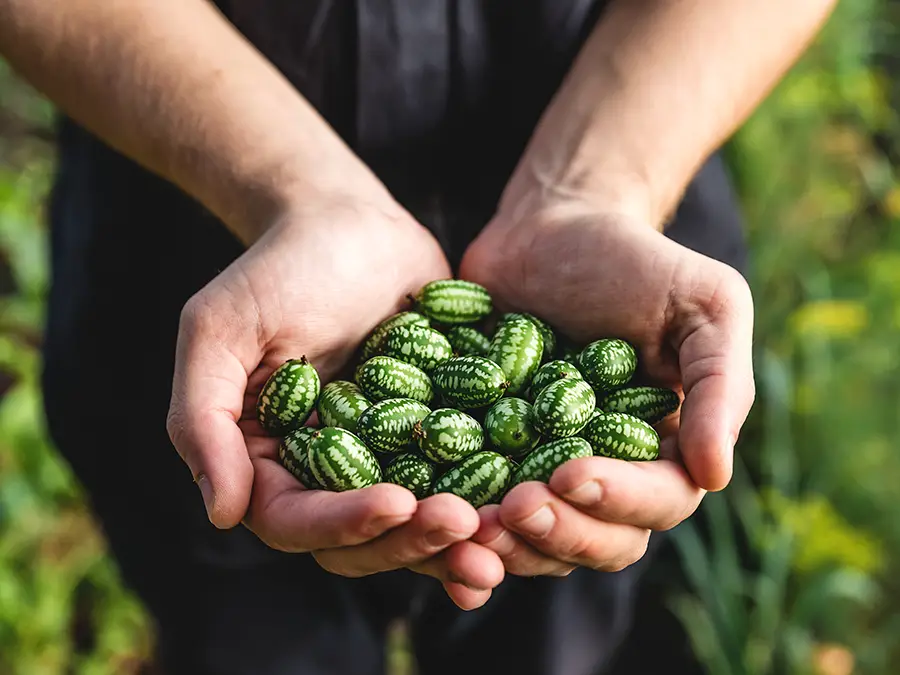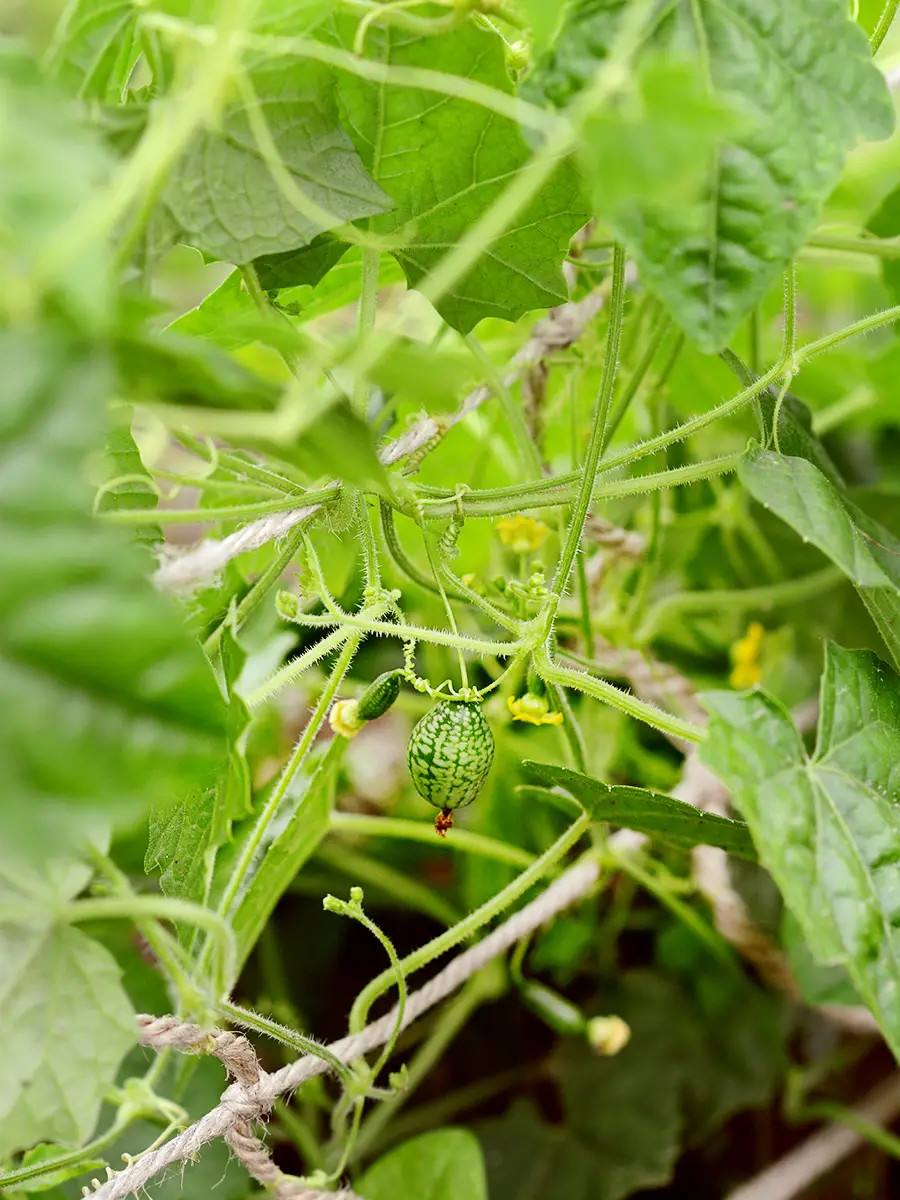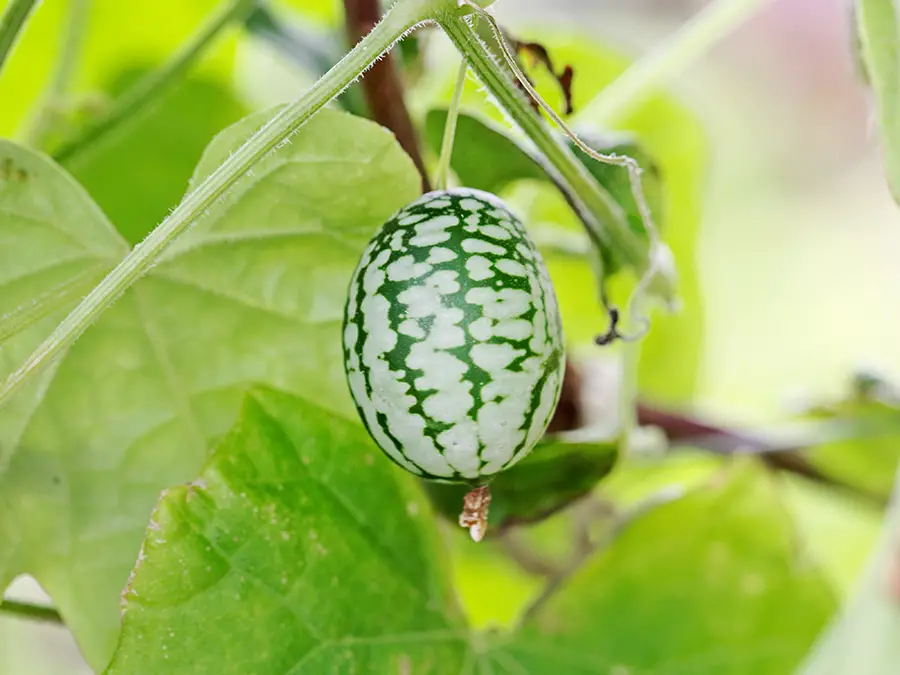How to Grow Cucamelon and Keep Them From Turning Sour

The cucamelon, which looks like a tiny watermelon, yet tastes like a citrusy cucumber, can be easily grown in your backyard garden. Even though the cucamelon grows best in warm climates and originated from Mexico and Central America, with a few special care tips, you can grow them too.
- Cucamelon Quick Facts
- Botanical Name—Melothria scabra
- Common Names—Cucamelon, Mexican Sour Gherkin, Mexican miniature watermelon, Mexican sour cucumber, Mouse Melon, sandita, or pepquino
- Plant Type—annual fruit, though it can be a perennial in tropical climates
- Size—can vine up to 10 feet
- Spacing—½ deep, 18-36 inches between plants, provide a trellis
- Ideal Climate—full sun, USDA Zones 2-11, ground temps 60 F and up
- Can it Be Started Indoors and Transplanted—yes
- Taste—tangy cucumber
- Growth—80 days to maturity
- Harvesting—look for fruit 1 week after yellow blossoms appear, harvest when 1 inch long
What Does a Cucamelon Taste Like?
Cucamelons taste like a cucumber with a squeeze of lemon. A cucamelon is about one inch in length, and it looks like a grape tomato. The skin of the cucamelon is very thin, almost translucent. The fruit inside is very juicy (cucamelons are 90 percent water!) You can eat them like grapes. They are usually eaten raw, so they have a crunchy texture.
Cucamelons are wonderful eaten right off the vine and are best harvested within one week of flowering. The longer a cucamelon ripens, the more tart and sour it becomes. So to get cucamelons with that perfect hint of tartness that’s not too overwhelming, it’s best to pick them as soon as they reach 1 inch long.
Cucamelons make quite the conversation piece and are perfect for lunchboxes, to share with coworkers, and in salads. You can also can the cucamelon to make pickles out of them. They are incredibly tasty anyway to eat them.
Where Do Cucamelons Come From?
Cucamelons are known to have been part of the Aztec diet. They are a staple in Mexico and Central America because of their warm climates. The first European reference we have of the cucamelon was by a French botanist named Charles Victor Naudin in 1866. When the fruit was introduced to North American gardeners in the 1980’s, the name cucamelon was coined to describe its appearance as a mini watermelon from the cucumber family.

How Do I Plant a Cucamelon?
Seeds—The cucamelon plant is best sown directly into the ground or in a raised bed garden after the danger of frost is gone. They do well when daytime temperatures have reached 70 to 75 F. My grandfather swears by a ground temp thermometer to let him know when it’s time to plant. Cucamelon seeds like warm weather, and won’t germinate in soil less than 60 F.
Cucamelons are prolific vining plants so they will do best when given a trellis to vine up around. Plant your seeds ½ deep and 18 to 36 inches apart. The seeds will generally germinate in 7 days but can take up to 14 days to germinate. Cucamelons need to be planted in an area with full sun.
Watering—When you first plant your cucamelon seeds, whether in the ground or in containers indoors, you’ll need to water them frequently until they germinate. Anywhere from twice a day, to every other day, is good for watering seeds. Decide how often to water by checking the moisture of your soil. You don’t want the soil around your seeds drying out completely, but you also don’t want to drown your seeds. Simply check the soil by sticking your finger to test the moisture and water accordingly.
Once your seeds have germinated and are grown, about one to two weeks after planting, you can begin to water less often. It’s best to water an established garden more deeply and space waterings further apart rather than daily. In general, gardens can be soaked with 1 inch of water or rain once a week. If you get rain, you only need to supplement whatever amount of water is left up to 1 inch of rain.
Soil—Cucamelon plants need good drainage, so you’ll want to make sure you have a good mix of organic compost and high-quality topsoil. Perfect soil should be able to pass the squeeze test. If you squeeze it in your hand, it will hold together. But if you run your fingers through it, it will fall apart.
If your soil is too hard, consider amending it with compost to allow for better drainage and oxygen. If you are using raised beds or tilling soil into your inground garden bed, try one of these soil recipes. Remember, your garden will only be as good as your soil.
There are many different recipes for the best garden soil, but the two most popular are:
- 60/30/10—60% topsoil, 30% compost, and 10% potting soil (this is actually a soilless blend of peat moss, vermiculite, and/or perlite.
- 50/50—50% topsoil and 50% compost
When buying your topsoil, you’ll need to do a little sleuthing to make sure it’s good quality. Signs of high-quality topsoil are:
- Regionally sourced ingredients listed on the bag
- Nationally recognized compost certification on the bag
- Passes the squeeze test, sticks together when squeezed, but then falls apart again when you run your fingers through it
- Is not fill-dirt that some companies mistakenly call top-soil
Can I Grow Cucamelons in a Cold Climate?
Because cucamelons love warm climates so much, you may be wondering if you can grow them in cold climates with a short growing season. The answer is yes! Cucamelons can grow in USDA hardiness zones 2 through 11. They take approximately 80 days from germination to harvest, so if you have a short growing season, try starting your cucamelon seeds inside.
You can start your cucamelon seeds inside near the window, or under grow lights. You can also start them in a small greenhouse like this one. Most gardeners like to start their plants inside about six weeks before their zone’s last frost date.
Once you’re in the clear from a freeze, you can harden off your cucamelon plants by reducing watering, and carrying them outside for increasing hours each day for a week. This hardening process gradually gets your plants accustomed to being in the more harsh outdoor conditions to reduce shock and root damage when you transplant them to your garden.
If you are still worried about frost or cold temps, you can use cloches made from recycled and cut-up plastic bottles, or you can use row covers to give them some extra insulation.
If this sounds like too much work, and your growing season is at least 80 days or longer, you can start your seeds right in the garden when it warms up.

How Long Do Cucamelons Take to Grow?
Cucamelons take about 75 to 80 days to be ready to harvest. The first 1 to 2 weeks of that is for the seeds to germinate. You can use succession planting, where you sew groups of seeds in succession several weeks apart to space out your harvest. This helps you not be overwhelmed by so many ripe cucamelons at once.
The cucamelon plant is very prolific and will provide you with plenty of fruit for you and your family, plus more to share. So succession planting can help spread out the abundance.
Remember it’s important to harvest your cucamelons as soon as they reach 1 inch long, or about a week after you notice the yellow flowers on your plant. This timely harvesting is the key to cucamelons that are perfectly tart, but not so much so that you don’t want to eat them.
Do I Need a Trellis for My Cucamelon Plant?
Yes, a trellis is recommended for your cucamelon plant. Because it is a vining plant, if it doesn’t have a trellis to grow on, it will shoot out 10 feet in any direction across the ground. This will create chaos in your garden and will probably cause your cucamelons to be stepped on and ruined.
If your cucamelon plant is allowed to vine out over the ground, it also makes the fruits harder to find while you’re harvesting. Your trellis doesn’t have to be fancy. It can be a fence, a trellis you construct yourself, or as simple as two stakes with twine or wire crossed back and forth between them.
How Do I Know When a Cucamelon is Ripe?
The first sign your cucamelon plants are getting ready to produce fruit for you is their beautiful yellow flowers. Even though they are from the cucumber family, expect your cucamelon plant to flower later than your cucumber plants. About a week after you first see these flowers, you can start looking for the cucamelon fruit. You’ll have to look closely because cucamelons hide in the leaves and can be hard to find.
Once your cucamelon is about one inch long, it’s time to harvest and you know it’s ripe. If you wait longer, your cucamelons will become tarter. Although this may be a fun experiment to try and see exactly how tart you like them or can stand to eat. They are like nature’s sour candies the kids will love to try.
When your cucamelon fruits are harvested frequently, this also helps with the plant’s production. As each fruit is picked, the cucamelon plant will grow more fruit to replace it, for months of wonderful eating depending on the length of your growing season.
To avoid damaging the vines, try to gently pick or cut the fruits off the vines rather than roughly pulling them.

Can I Save Cucamelon Seeds?
You can propagate your own cucamelons for next season. It’s simple and will save you from buying seeds the next year. Simply follow these steps to save cucamelon seeds.
- Leave some of the fruits on the vine near the end of your growing season until they overripen and turn yellow
- Remove the overripe fruits and cut them in half
- Separate the seeds from the pulp, and place the seeds in a jar of water for 2 days
- The seeds that sink to the bottom are the good seeds, discard everything else and rinse the good seeds
- Dry your saved seeds in a single layer and save them in an envelope to use the following year
How to Overwinter Cucamelon Tubbers
Another option for repurposing this year’s plant for next year is to overwinter the tubers your cucamelon plant produces. The benefit of starting from tubers is your plants will often take off much more quickly, flower earlier, and produce a more abundant harvest.
If you live in zones 7 through 12, it is warm enough you can overwinter your tubers in the ground. To overwinter in the ground, cut back your plant and gently feel in the ground to check if your cucamelons did produce light cream-colored tubers. If you find some, you can deep mulch that area with one foot of hay or leaves. Once the ground has warmed up to 60 degrees the following spring and you are out of danger of frost, you can begin watering your ground tubers again.
If it’s too cold in your area to overwinter in the ground, you can overwinter them in a pot of soil in a moderate temperature area like a greenhouse, root cellar, or moderately heated garage. The ideal temperature to overwinter cucamelon tubers in a pot of soil is around 45 F. If your temps are higher than that your tubers will rot.
At the end of your growing season, you’ll want to dig carefully for the delicate tubers. If you try and pull them up, they can be damaged. The tubers will grow down underneath the root ball. Your best option is to gently dig about one foot away from your plant and slowly bring the earth up.
Using your hands can also help reduce tuber damage from over-enthusiastic digging. One dug up, place them gently in a pot of premoistened potting soil. Make sure they are layered with soil above and below, and that the tubers are not touching each other.
In the spring, you can begin giving them water and light 6 weeks before your last frost to get a head start on your growing season, or you can wait and plant them directly in your garden soil.
How Do I Eat a Cucamelon?
Cucamelons are wonderful eaten right off the vine. In fact, it’s hard to wander into the garden and not pick handfuls of cucamelons to eat. They are delicious just as they are.
Many people like to use them as you would cucumbers or grape tomatoes. You can pack them as-is for a quick snack, or add them to fresh garden salads. Cucamelons are also great pickled or added to a quinoa salad. It is even said that cucamelons are used in Mexican bars as appetizers in bowls like you would a bowl of peanuts.
Ready to get started planting a garden? Check out our Complete Guide to Gardening at Home + 5 Beginner Mistakes to Avoid.
How about you, have you ever tried a cucamelon before? What has your experience been like growing them in your garden? Let us know in the comments below.

2 Comments
This is my first year growing cucamelons, and I will save seeds and grow them again. My husband is not a big fan, but that may be because their vining nature (and he made an excellent climbing trellis for them out of the bamboo we have growing), they pretty much took over the arbor. He was afraid the beans would be crowded out I think, but they shared space very well. I have munched on them raw, but harvested my first good-sized batch today and will make a cucumber salad from them. Next batch I will pickle for winter use. They are being well pollinated by a few bumble bees. With the loss of many insects that usually pollinate our garden, I am very grateful for the bumble bees. They are so gentle and don’t mind me picking next to where they are working. The cucamelons only require a small footprint when you provide a good climbing space for them. I started ours indoors and transplanted outside when the weather warmed up. I only planted them a foot apart (I only started six plants) as the soil for the raised bed they are in is rich. It seems to suit them well. BTW it looks like the six plants will provide plenty of fresh and pickled cucamelons for the two of us. Prolific is their middle name!!
Sandi thank you for sharing your incredibly valuable insight with our readers! It was delightful to read about your experiences growing cucamelons. It sounds like you tended to their unique needs very well. I would love to try picking them, what a great idea. What hardiness zone do you garden in?